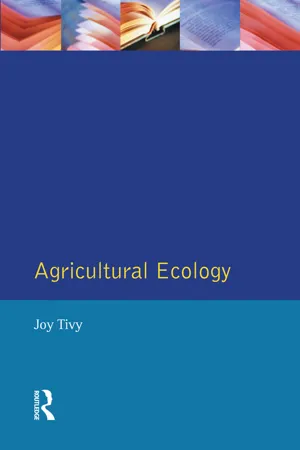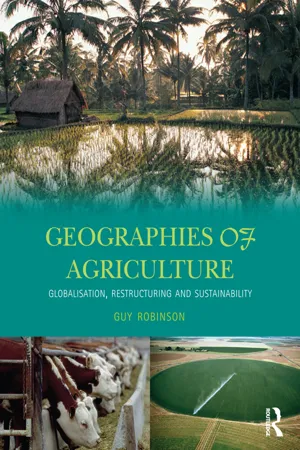Geography
Agriculture and Pollution
Agriculture can contribute to pollution through the use of chemical fertilizers and pesticides, which can contaminate water sources and soil. Livestock farming also produces methane and ammonia emissions, contributing to air pollution. Additionally, agricultural activities can lead to soil erosion and deforestation, further impacting the environment.
Written by Perlego with AI-assistance
Related key terms
5 Key excerpts on "Agriculture and Pollution"
- eBook - ePub
The Rural
Critical Essays in Human Geography
- Richard Munton(Author)
- 2017(Publication Date)
- Routledge(Publisher)
In this paper we examine the regulation of agricultural practice to reduce the risks of water pollution in England and Wales. We present case-study material concerning water pollution from farm livestock effluents and from agricultural pesticides, and focus on the ways in which farmers and farming practices are being reconfigured under the banner of a move towards a ‘more sustainable agriculture’. Pollution policies can be seen as attempts not only to ‘stabilise’ nature in the rural environment, but also as a process of social ordering as farmers are recast as responsible environmental managers with newly instrumentalised self-governing properties. Introduction In Mary Douglas’s celebrated phrase, pollution is ‘matter out of place’. In her study, Purity and Danger (1966), she demonstrated how societies construct categories of what is natural and what is unnatural with the boundary between them morally charged. The past decade has seen the creation of a new and compelling category of ‘agricultural pollution’ across the Western world, with the result that governments are developing policies and measures to encourage or cajole farmers into ‘keeping matter in its place’. The techniques for the environmental governance of agriculture require that state agencies shape not only the context within which actors make decisions (Miller and Rose, 1990; see also Foucault, 1991) but also the ways in which actors make sense of and respond to this context by means of their capacity for self-calculation and self-regulation (Burchell, 1993) - eBook - ePub
Human Ecology
The Story of Our Place in Nature from Prehistory to the Present
- Bernard Campbell(Author)
- 2017(Publication Date)
- Routledge(Publisher)
In summary, the development of agriculture is the first of the major cultural advances that has transformed the biosphere by permitting an immense multiplication of the human species. Agriculture has made possible civilization and given humans the opportunity for leisure. It has freed the human spirit from the endless search for food and shelter.Agriculture has thus been of unquestionable benefit to humanity, but in our attempt to extract more and more resources from our environment by removing the limiting factors of water, mineral availability and the parasites and predators of plants (as well as animals), we have developed chemical products which are proving very damaging to the planet. All the major rivers of N. America, Europe and Asia are seriously polluted, and in the USA 64% of the pollutants are of direct agricultural origin.Humans themselves also generate toxic wastes, either directly, or through their industries. In India, the rivers, including the sacred Ganges, are little more than open sewers. 600 km of the Ganges are dangerously polluted with human and animal wastes together with an increasing amount of the toxic and hazardous effluent from industry and agriculture. Fifty-four out of 78 major rivers in China are seriously polluted with sewage and industrial wastes.There is some reason to believe that a growing awareness of this terrible problem is engendering a response among politicians who at last are beginning to vote the large sums of money needed for the installation of water treatment plants. But we have a very long way to go to transform and recycle the waste products of over 5 billion people.REFERENCES
1 . Conklin, H. C. 1969 An Ethnoecological Approach to Shifting Agriculture. In Environment and Cultural Behavior A. P. Vayda, ed. (New York: Natural History Press).2 . Leach, G. 1976 Energy and Food Production (London: IPC Press).3 . Richards, L. A. 1969 Saline and Alkali Soils (Washington: US Department of Agriculture).4 . Wahab, A. 1964 The Soil Problems of West Pakistan. In The Role of Science in the Development of Natural Resources, with Particular Reference to Pakistan, Iran and Turkey - eBook - ePub
Dirty Words
Writings on the History and Culture of Pollution
- Hannah Bradby(Author)
- 2013(Publication Date)
- Routledge(Publisher)
CHAPTER FIVE AGRICULTURAL POLLUTION: THE PRICE OF PROGRESS? JANET ROWE EARLY DAYS: A NECESSARY BALANCE WITH NATURESince neolithic times, people and their agricultural activities have had a profound effect upon the environment of what is now the UK. As the hunter-gatherers gave way to herders and cultivators, the land surface was progressively cleared of the wildwood. The earliest revolution in land-use came with the discovery that if land was fallowed, or rested for a season or more, it could be kept in cultivation. This allowed settlement, and increases in population. Drier and more accessible areas came first into agriculture. Soils in some of these situations were thin and prone to erosion, for example over the chalk, or in sandy areas, or where underlain by impermeable rocks. If cultivation occurred, it was relatively short-lived, and re-colonization by bushes and trees was only patchy. Animals could be extensively grazed, however, often with the associated use of more fertile pastures. It is largely this management which has given us the downlands, heathlands and moorlands of today.On heavier, more fertile land, a pattern of open fields, usually strip-farmed, meadows and commons, copses and woodlands developed, all useful and managed for products of different kinds. Such mixed farming and extensive management has given us our ancient woodlands, hedgerows and lowland meadows. Enclosure in the eighteenth and nineteenth centuries, as population increased and there were greater profits to be made from more advanced stock-rearing and cropping methods, changed the patterns and gave us more hedgerows and walls; but rotation and inter-relationship between the different facets of land management were still essential. There was little except marl and lime which could be brought in to assist production, so resources had to be safe-guarded. - eBook - ePub
- Joy Tivy(Author)
- 2014(Publication Date)
- Routledge(Publisher)
With increasing intensity of farming, interactions between agro-ecosystems and other non-agricultural systems have escalated. The outputs of one have become the essential or non-essential and even harmful inputs of another and vice versa. Further, the intensive production of crops and livestock has acquired many of the characteristic features of the manufacturing industry such as a high capital expenditure on machinery and buildings, specialization of production, increasing efficiency of production and a large output of waste byproducts. Agriculture waste material is now a significant source of air, water and soil pollution and an externality which imposes often high economic and social costs on other systems. Conversely, agroecosystems have become the recipients of pollutants produced elsewhere.Until relatively recently concern about problems of increasing pollution and the associated environmental degradation focused attention mainly on urban-industrial complexes as the main sources of pollution. It was not until after the Second World War that the environmental impact of agriculture began to make itself felt. Awareness of the actual or potential consequences were heightened by the rate of change in agricultural methods at a time when public and private concern for conservation and environmental quality was becoming vocal.ACCELERATED SOIL EROSION
The first and still the most deleterious impact of agriculture on the environment is accelerated soil erosion. Soil erosion is a natural process which has been speeded up as a result of the removal of a natural or semi-natural vegetation cover, and the exposure of the underlying soil to the direct impact of precipitation, sunlight and wind. Tillage disturbs the soil and opens it up. As a result, increased temperature and aeration speed up the decomposition of organic matter; and this is accompanied by a decline in the structural stability of the soil. It becomes more susceptible to transport by either wind or water, depending on local climate and land gradient. Accelerated soil erosion would have been initiated by deforestation and soil tillage. It early affected the highly populated and technically advanced agricultural societies of the Middle and Far East (particularly Northern China). The eventual decline of these societies has been attributed, at least in part, to the ravages of soil erosion and the decline in the efficiency of irrigation schemes and/ or river flow as a result of the progressive silting of reservoirs and water channels. Awareness of the magnitude and universal extent of soil erosion emerged in the late 1920s and early 1930s, when cultivation was pushed into the semi-arid temperate grassland areas of the world. With the onset of a period of prolonged drought in the 1930s the exposed dry soils started to blow; and the impact of the Dust Bowl conditions in South-Western USA was felt as far afield as the eastern seaboard. In the period immediately prior to the Second World War, soil erosion was as emotive an issue as pollution or acid rain is at present. The publication of Jacks and Whyte’s (1939) book The Rape of the Earth - eBook - ePub
Geographies of Agriculture
Globalisation, Restructuring and Sustainability
- Guy Robinson(Author)
- 2014(Publication Date)
- Routledge(Publisher)
2 The changing focus of agricultural geography2.1 ‘Traditional’ agricultural geographyThis chapter focuses on how the content of agricultural geography has evolved post-1945, thereby providing a context for the more extended consideration of key components of agricultural change in the rest of the book. Emphasis is placed upon how there has been a move from a ‘traditional’ form of agricultural geography to new approaches embracing different ideas from across the social sciences.A standard definition of agricultural geography in the mid-1980s referred to ‘the description and explanation of spatial variations in agricultural activity over the earth’s surface’ (Ilbery, 1985a, p. 1). This interpretation was based largely on consideration of two major avenues of enquiry that had dominated agricultural geography in the twentieth century:• Location and context, in which emphasis was placed on the regional characteristics of agricultural activities, especially broad trends and tendencies (Coppock, 1968; 1971).• Explanations of agriculture’s great diversity, through consideration of relationships between the large number of relevant variables associated with social, economic, physical and historical factors affecting agriculture (e.g. Grigg, 1992a).The regional focus in the first of these can be traced to the first time that a specialism specifically termed ‘agricultural geography’ played a leading role in the development of geography as an academic discipline. This was in the 1920s when agricultural geography was one of the principal specialisms that emerged as part of the growth of regional geography as the discipline’s central paradigm (Johnston, 1997, pp. 44–52). An example of this was Baker’s (1926) work on the recognition of ‘agricultural regions’ in different parts of the world. The region became the central focus of study for agricultural geographers, with both singleattribute and multi-attribute regions being recognised. Indeed, for the first half of the twentieth century agricultural geography involved regional delimitations following large-scale mapping of distributions of crops and livestock (e.g. Robertson, 1930) and the classification of agricultural systems (e.g. Whittlesey, 1936). Prevailing ideas on environmental determinisim emphasised the physical controls exerted upon the nature of agricultural activity. Description of agricultural variations was important, with land-use mapping of significance in some countries, a good example being the Land Utilisation Survey of Great Britain, begun in the 1930s by the geographer L. D. Stamp (1948).
Learn about this page
Index pages curate the most relevant extracts from our library of academic textbooks. They’ve been created using an in-house natural language model (NLM), each adding context and meaning to key research topics.




